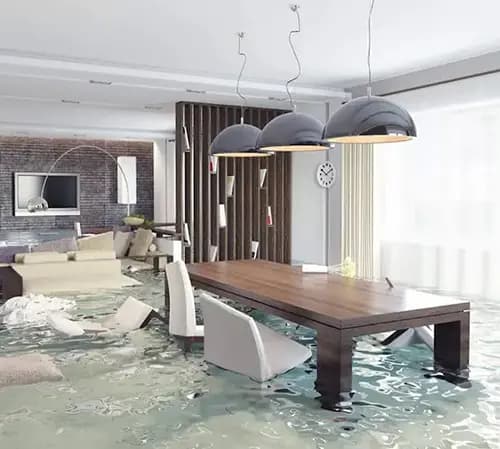Can Flood-Damaged Items Be Salvaged or Should They Be Replaced?

Floods can wreak havoc on homes and businesses, leaving behind a trail of destruction that challenges property owners. One of the most pressing questions after such an event is whether flood-damaged items can be salvaged or if they should be replaced altogether. This decision significantly impacts both your recovery timeline and your budget. In this article, we explore how to determine which possessions can be saved and when replacement is the better option. We’ll also highlight the importance of professional flood damage restoration and Flood Damage Restoration Service providers like Ideal Response to guide you through this process efficiently.
How Does Flood Damage Affect Household Items?
Floodwaters often carry dirt, sewage, chemicals, and other contaminants, turning your belongings into potential health hazards. The type of damage varies based on the material and how long the items were submerged. Some items may only suffer superficial damage, while others might be irreparably harmed.
- Porous materials such as carpets, upholstered furniture, and drywall absorb water deeply, making them harder to clean and dry.
- Non-porous materials like metal and glass may be easier to salvage as they don’t absorb water.
- Electronics and appliances exposed to floodwater usually suffer extensive damage because water can short-circuit delicate components.
Understanding the nature of damage is key to deciding whether to save or replace items after a flood.
What Factors Determine if Flood-Damaged Items Can Be Salvaged?
Several factors influence whether an item can be restored or must be discarded. Consider these key points:
- Extent of Water Exposure
Items submerged for a short time in clean water might be salvageable. However, if they were soaked in contaminated floodwaters for extended periods, restoration becomes more complicated. - Type of Material
Porous items often harbor bacteria and mold even after drying. These materials are harder to clean and disinfect. In contrast, hard, non-porous items have a better chance of being restored. - Structural Integrity
If an item’s structural integrity is compromised, like wood that has warped or metal that rusted, replacement might be safer and more cost-effective. - Health Risks
Items that pose health risks if retained, such as mattresses, pillows, and stuffed toys, generally should be replaced to avoid mold and bacteria issues. - Cost of Restoration vs. Replacement
Sometimes restoring an item can cost more than buying a new one. Professional assessments can help you weigh these options.
Can Furniture Be Salvaged After Flood Damage?
Furniture is often one of the most valued possessions affected by flooding. Whether it can be salvaged depends on the furniture’s material and the contamination level of the floodwater.
- Wood Furniture: Solid wood pieces may be dried and restored if caught early. However, veneered or particleboard furniture often swells, warps, and delaminates, making replacement necessary.
- Upholstered Furniture: These pieces absorb water deeply, making them prone to mold growth. Restoration may be possible if the water was clean and drying started immediately, but often, replacement is safer.
- Metal Furniture: Usually salvageable if cleaned promptly and treated to prevent rust.
Professional flood damage restoration service providers like Ideal Response have the expertise and equipment to assess and restore furniture when possible, ensuring safety and hygiene.
What About Carpets and Flooring? Should They Be Replaced or Cleaned?
Floodwaters frequently ruin carpets and flooring, especially if water remains stagnant. Here’s what to consider:
- Carpets: If soaked in contaminated water, carpets and their padding usually require replacement because mold and bacteria can hide deep inside. For clean water exposure, professional cleaning might save them.
- Hardwood Flooring: Prolonged exposure to water can cause wood to warp and buckle. Some hardwood floors may be sanded and refinished, but extensive damage means replacement.
- Tile and Vinyl: These floors often survive floods but need thorough cleaning and drying to prevent mold in the underlying layers.
Hiring a skilled Flood Damage Restoration company ensures that your flooring is evaluated correctly and cleaned or replaced according to industry best practices.
Can Electronics and Appliances Survive Flood Damage?
Flood-damaged electronics and appliances face severe risks because water damages internal components.
- Electronics: Items like TVs, computers, and phones are typically not salvageable after floodwater exposure. Water can cause corrosion and electrical failures that may not be visible immediately.
- Appliances: Some appliances may be repairable, but many will need replacement due to safety hazards.
Attempting to use flood-damaged electronics or appliances without professional inspection is dangerous. Ideal Response includes expert technicians who evaluate these items safely and advise you on the best course of action.
When Should You Call a Professional Flood Damage Restoration Service?
Deciding whether to salvage or replace flood-damaged items isn’t always straightforward. This is where expert Flood Damage Restoration Services play a vital role. Professionals like Ideal Response provide:
- Comprehensive Damage Assessment: They evaluate every damaged item to determine salvageability.
- Safe and Efficient Cleaning: Specialized equipment and disinfectants remove contaminants effectively.
- Mold Prevention: Immediate drying and mold treatment reduce health risks.
- Proper Disposal: Unsafe items are discarded according to regulations, protecting you and the environment.
- Insurance Assistance: Many restoration services help with documentation and claims.
Hiring professionals not only speeds up recovery but also ensures your safety and property’s long-term health.
How Can You Prevent Further Damage After Flooding?
Taking quick action after flooding is crucial to improving salvage chances:
- Remove Standing Water: Use pumps and wet vacuums to extract water quickly.
- Ventilate and Dry: Open windows and use fans or dehumidifiers to speed drying.
- Discard Unsalvageable Items: Remove wet porous materials promptly to avoid mold growth.
- Avoid Using Damaged Electronics: Do not plug in or operate wet appliances or devices.
Professional Flood Damage Restoration Service providers have the tools and know-how to implement these steps safely and effectively.
What Role Does Insurance Play in Flood Damage Restoration?
Understanding your insurance coverage is essential in the decision to restore or replace damaged items. Many homeowner’s policies exclude flood damage, so you might need separate flood insurance.
- Documentation: Keep detailed records and photos of damaged items.
- Consult Your Provider: Know what items your policy covers and what proof they require.
- Work with Restoration Experts: Companies like Ideal Response can provide detailed reports to support your claim.
Effective communication with your insurer can reduce out-of-pocket expenses and help you recover faster.
Conclusion: Should You Salvage or Replace Flood-Damaged Items?
Ultimately, the choice between salvaging or replacing flood-damaged items depends on safety, cost, and practicality. While some possessions can be restored, others pose health risks or are no longer structurally sound.
For the best outcome, rely on expert Flood Damage Restoration and Flood Damage Restoration Service providers like Ideal Response. Their knowledge and equipment ensure that salvageable items are properly cleaned and dried, while unsafe items are responsibly replaced. This approach protects your property, your health, and your peace of mind as you rebuild after flood damage.


